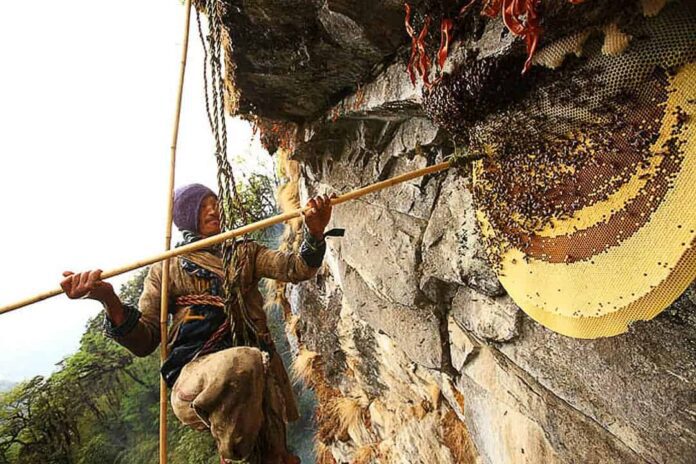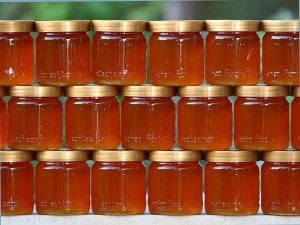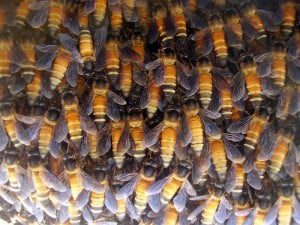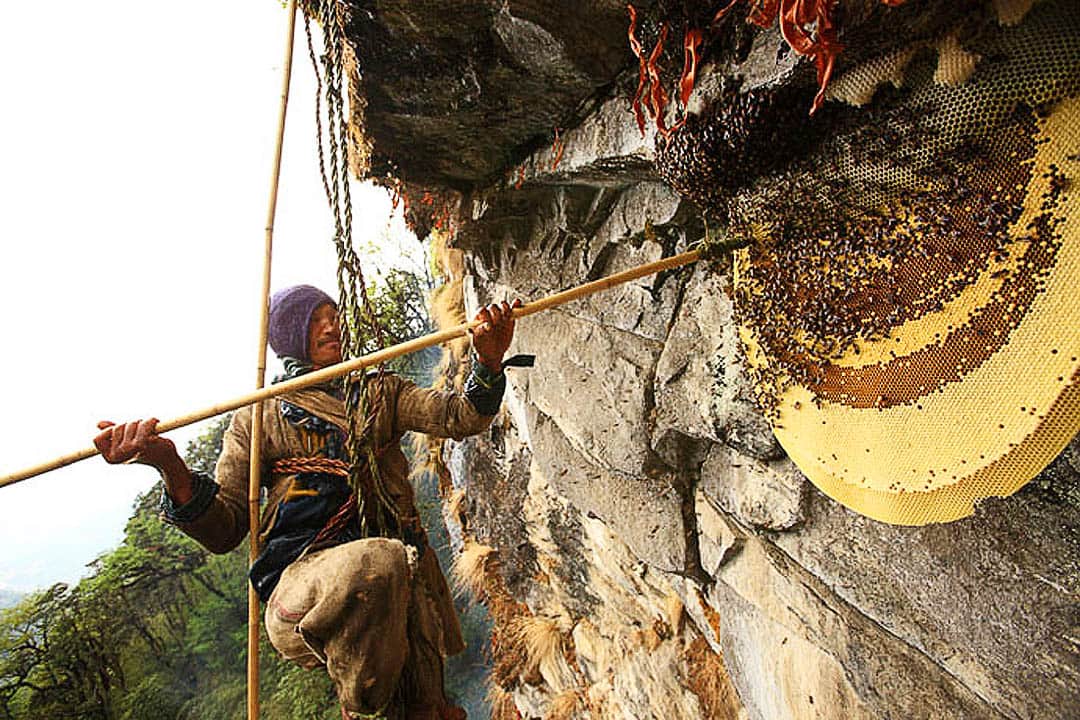Within the depths of the forests in the Himalayas, lies the world’s largest bee’s that spend their time creating psychedelic honey that will blow your mind. This particular honey is so valued by the locals in Nepal and China that they willingly risk their lives to potentially harvest and sell this honey to the wealthy men of asia and the curious tourist that frequent the area. What makes this ‘mad honey’ so desirable and special?
The term mad honey which is also known as red honey, is the product of the Himalayan cliff bee or (Apis dorsata laboriosa). This bee is the largest in the world which are just over 3cm long and they are a subspecies of the relatively common bee (Apis dorsata). This highland bee is the only species in the area that has access to Rhododendron flowers that tend to make the highly sought after honey mad.
Many of the Rhododendron species contain what’s called gray anon toxins, which makes them quite poisonous to us humans. Yet in the highlands of Himalayas which consist of Yunnan (China), Bhutan, Nepal and India, this rare Himalayan cliff bee resides right alongside the Rhododendrons (Rhododendron luteum and Rhododendron ponticum), which are the flowers that the bees tend to collect their nectar from.
The honey that is produced from the nectar that the bees obtain from the Rhododendron flowers tend to come with some extremely potent properties. Red honey or what some people call mad honey is known to contain extremely a powerful hallucinogen that is used as a recreational drug as well as a medical one as well. This particular honey is thought to be extremely effective at treating from diabetes and poor sexual performances all the way to hypertension, but only when taken in very small doses. If taken in high doses this hallucinogenic honey can become highly toxic and in some cases even fatal.
In small doses however the honey becomes intoxicating, being able to give off the feeling of pleasant dizziness, relaxation along with a tingling sensation that goes along with it. Yet having the ability to be hallucinogenic, there is not much in regards to scientific literature regarding the effects of the honey.
When this honey is consumed in high doses however, it tends to cause Rhododendron poisoning or honey intoxication, which is described by progressive muscle weakening, heart irregularities, and to top it off the symptoms include vomiting.
King Mithridates’ army back in 67 BC used this mad honey as a type of natural chemical warfare and left large chunks of the honeycomb where the Invading Roman army could find it. Needless to say, while the entire army was pretty much high off their rockers, they were easily defeated.
Although the properties of mad honey tend to be pleasant and harmful, are due strongly to the gray ano toxins that reside within it, which drives from the nectar of the local Rhododendron.
What are Grayanotoxins?
They are a group of toxins tend to be produced by the Rhododendrons and the other plants that are in the Ericaceae family. Since this type of honey has intoxicating and medicinal effects, this honey tend to fetch a very high price, which often runs about four or five times the price of normal honey.
Yet the bees have quite difficult for the locals in the area to farm, because in the Himalayan mountains, altitudes get well over 2500m. The cliff bees normally build gigantic nests that are constructed on overhanging rocks of the Southwestern facing cliffs.
The sizes of these nests can become extremely large and can get up to 5ft in diameter and contain about 60 kg of honey in them, which helps add to the difficulty of harvesting the honey from them. The locals normally collect two different batches of the honey, once in the spring and then again in the autumn, however the honey collected in the spring times is the only time the the honey tends to truly pack a punch.
Below is a documentary that helps put into perspective just what lengths these locals will go through to obtain and harvest this rare and highly intoxicating honey.



